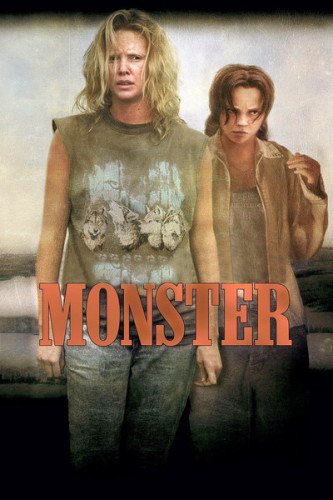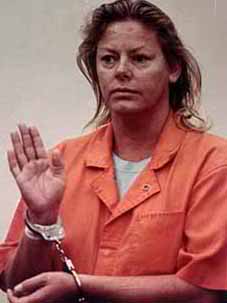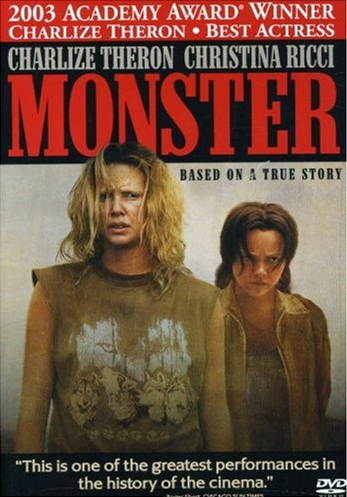This guest post by Danika Kimball appears as part of our theme week on Violent Women.
American film audiences love the idea of violence, especially in regard to justice. From Bruce Wayne’s masked forays as Batman, to Frank Underwood’s signature House of Cards sneer, pop culture and media landscapes are bombarded with the image of a vigilante bringing matters into their own hands to enact justice. But what is almost more widely revered is the concept of a woman taking matters into her own hands, as it defies societal norms on numerous levels.
We see this depiction in numerous films. To the audience’s delight, heroine Beatrix Kiddo takes vengeance on her abusers in the Kill Bill series, and Furiosa defiantly defends her right to redemption from evil doers in Mad Max: Fury Road. But sometimes, females who resort to violence aren’t celebrated, and there is perhaps no greater depiction of this than Charlize Theron’s embodiment of Aileen Wuornos in the widely acclaimed dramatic film, Monster.
Monster is a film based on the life of Aileen Wuornos, who was one of the first female serial killers in the United States. Wuornos, an impoverished former prostitute, was executed in Florida in October 2002 for the murder of six men, each of whom were her former customers. She was only the second woman in Florida and the tenth women in the United States to receive the death penalty since the landmark 1976 Supreme Court decision that restored capital punishment.
The film made an impact on most for its graphic depictions of murder, but upon re-watching the film 10 years later, the portrayal of Aileen’s life in Monster was a cruel visualization of the impacts of patriarchy, poverty, and the ways in which the criminal justice system fails violent women.
In the opening scenes of Monster, we see Aileen as an adult sitting under a busy highway overpass, replaying her life story. We see her as a young child, dreaming of being an icon like Marilyn Monroe, wealthy, loved, and the center of attention.
Her fantasy fades as she walks into a gay bar with the five dollars she had just earned from a John which she was determined to spend before she ended her life. It’s here she meets a woman named Selby, a person she would later devote to protect at any cost.
The pair eventually find solace in their shared loneliness and fall in love, which pushes Selby out of her compulsory heterosexuality. Aileen, finally having someone to care for, takes it upon herself to be a provider for Selby. The film follows Aileen’s struggle to support her newfound family, her efforts in making sure that Selby is happy, and the struggle to maintain her own dignity.
After being raped and brutalized by a client, Aileen kills him in self-defense, vowing to quit prostitution. She confesses her crime to Selby, as Selby has been angry with her for not supporting the two of them.
Aileen’s efforts to find a job prove to be difficult she has no marketable skills, and no job history outside of her years of prostitution. Any prospective employers reject her, some openly volatile, accosting her for wasting their time. We see throughout the film that everyone in Aileen’s life believe that no man will ever pay her for anything aside from her body.
With nowhere to turn, Aileen returns to a life of prostitution, each time killing and robbing her Johns more brutally than the last, as she is convinced they are all trying to harm her.
In this context, it becomes difficult for a viewer to see her actions as evil. Aileen’s actions almost appear to be rational, even moral decisions, when viewed through the lens of extreme gender and class oppression. We see this in her explanations to Selby later, where she implores that she is helping to protect the other women in the world, who might also be victimized these men. She says,
Who the fuck knows what God wants? People kill each other every day and for what? Hm? For politics, for religion, and THEY’RE HEROES! No, no… There’s a lot of shit I can’t do anymore, but killing’s not one of them. And letting those fucking bastards go out and rape someone else isn’t either!
Eventually Aileen’s murders catch up with her, and she is arrested at a biker bar. While speaking to Selby on the phone, Selby reveals incriminating information over the phone while the police are listening in. As her last display of protection, Aileen admits she committed the murders alone. During the subsequent trial, Selby testifies against her in the courtroom hearings. Aileen is executed by lethal injection on October 9, 2002.
Part of what makes Monster so honest and relevant to feminists is the way that it recognizes and points to the patriarchal conditions in place that frame and constrain women’s choices, sometimes leading to a life of crime.
Throughout her life Aileen has been victimized, raped, and violence is a part of her day-to-day existence.
Emily Salisbury, a professor at Portland State University’s Criminology and Criminal Justice Program, suggests that patriarchal conditions are often a huge part of the reason for women’s participation in criminal activity and subsequent incarcerations. She remarks,
With the work of feminist scholars such as Mita Chesney Lynn, Kathleen Daly, Regina Arnold, Barbara Owen and many others, new ideas about female offending were established. The qualitative life history interviews that these scholars conducted with girls and women suggested that their lives leading up to criminal justice involvement were extremely complex and disadvantaged, with unique daily struggles…such as struggles with child abuse, depression, self-medicating behavior, self-hatred, parenting responsibilities, domestic violence and unhealthy intimate relationships. It’s argued that these problems create unique pathways to crime for women.
Many of the struggles listed are applicable to Aileen’s incarceration. In a documentary called Aileen Wuornos: Life and Death of a Serial Killer, director Nick Broomfield speaks to the infamous murderer, where she expresses that if her life leading up to adulthood had been more ideal, she wouldn’t have entered a life of crime in the first place. Family members and close friends remark throughout the film that she was the product of homelessness, violence, abuse, prostitution, poverty, incest, rape, and mental illness.
Throughout her life, Wuornos experienced horrific instances of gendered abuse, which eventually lead to a violent outlash at her unfair circumstances. Monster vividly documents the life of a woman whose experiences under a dominant patriarchal culture racked with abuse, poverty, and desperation led to a life of crime, imprisonment, and eventually death.
Though on-screen depictions of violent women are portrayed as empowering, as is the case with vengeful Furiosa in Mad Max, or the cathartic revenge plot for Beatrix Kiddo in Kill Bill, Aileen Wuornos’ story tells a different story for violent women. Monster illustrates that all too often, violent women’s pasts are rifled with oppression, and in defending themselves, they face consequences from legal systems that have proven to fail them in the past. For Aileen, violent self-preservation ended in demise.
Danika Kimball is a musician from the Northwest who sometimes takes a 30-minute break from feminism to enjoy a TV show. You can follow her on twitter @sadwhitegrrl or on Instagram @drunkfeminist.












